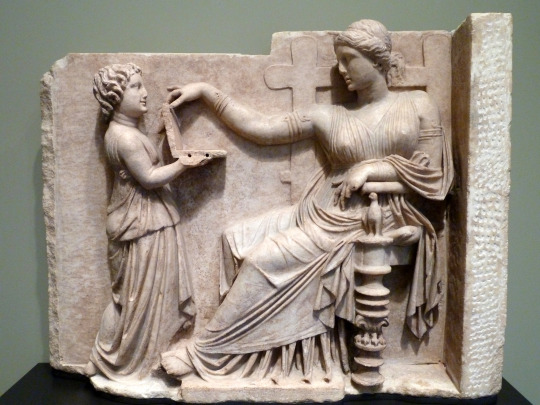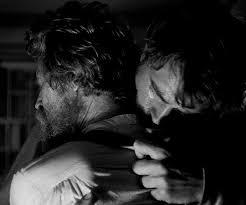Don't wanna be here? Send us removal request.
Note
#p<3
How different was the women's contribution and influence to society during the Minoan/ Hellenic/ Byzantine periods?
Minoan period: The Minoan society has been at times called matriarchal, however this is certainly an excessive characterisation that can't be easily supported, since the leader was a king and the higher ranks were occupied by men, with the exception of priesthood where women were just as prominent if not more. Women in Minoan Crete were associated with the typical role of the children and household caretaker. Women could also work in certain jobs as food collectors and cloth weavers and older women could become tutors of their jobs. The Minoan religion glorified fertility goddesses above all. It is well known that Minoan clothing often revealed the breasts but on the other hand there are absolutely no depictions of erotic scenes found, which suggests Minoans considered sex either too private and sacred or inappropriate. If we take this into account, the exposure of the breasts seems to allude to motherhood rather than sexuality itself. Other than that, female clothing was more covering than male clothing but also more embellished. Women participated in social activities, events and sports taking place in the city. They took care of their appearance.

Hellenic Period (NOTE: The Hellenic period includes the Archaic and Classical Eras. It doesn’t include Mycenaean and Homeric Age and it is followed by the Hellenistic and Roman eras. I am not sure if you mean the exact period or just generally the Ancient Greek period so I am gonna speak more broadly, just to be sure). The woman's position regressed severely during that time, getting worse and worse with every era. However, it differed depending on the region and what kind of woman you were. Spartan and Anatolian Greek women enjoyed more freedoms,while Athenian women of the Classical era were the most unfortunate, and slow improvements started with the Hellenistic period, with women having more chances at receiving an education. The absolute worst was to be a married woman in the Classical era. Adolescent girls, virgins, priestesses and, ironically, sex workers all had it better. The ideal married woman was confined in her house, concerned only with her children and household. She should be obedient and devoted to her husband and had no property of her own. A married woman could not attend social events and sports. Female roles in the theater were played by men. Even the shopping in the marketplace should best be done by the man. On the contrary, young girls could attend social events and could also dress more lightly than married women. Obviously, the mindset behind this was that they should find a husband but, still, they were less confined. Priestesses were respected. Sex workers had to be pleasant company, therefore they received education and were skilled in arts. Sex workers had higher chances to find true love, as it was not uncommon that men fell in love with them for having more complex personalities than the "respectable" women and married happily. Homosexuality wasn't that oppressed, mostly because it wasn't seen as a threat coming from another man. Most people would turn a blind eye to it. There are records of old women also sleeping with male prostitutes. Low rank women and poor women in desperate need for money would work out of the house, ironically also enjoying freer lives than respectable wives. Poor respectable wives. A man had the right of life or death over his wife and children, however we should also remember that killing a family member was considered heinous in Ancient Greece. I guess the man had to prove his wife had done something "horrible" for such an act to be swallowed. While these were the laws, it doesn't mean that different human beings didn't approach the issue differently. Women were buried with care and love and wealth when possible, with affectionate messages from their family members. There are instances of women bossing around or oppressing their husbands, a great example being Xanthippe, the wife of the philosopher Socrates. Women who had violated any “indecency” law could be forgiven or tolerated, if they gave strong enough arguments for their actions. Apart from all these, women had a huge presence in religion and arts, even though it was through the men’s perspective. Female deities were equally worshipped as male ones. Women were inspiration for numerous big or frequently titular roles in ancient literature. Women are depicted with complex personalities and various virtues and vices. They are as eloquent, thoughtful and as vital to the stories as men. The importance of women in arts often does not agree with the place they are believed to have had in the society. Maybe this could invite a re-evaluation of what is believed. I honestly have the impression (or hope) the reality might have been at least slightly less bleak that it is believed to be or we are overexposed to what was happening in Classical Athens.

Byzantine period: Despite how Christianity is typically associated with patriarchy nowadays, the deeply Christian Byzantine Empire was the best place to be a woman in the Middle Ages. While, as usual, a respectable wife was supposed to stay in the house, things weren't AS strict anymore. Even though the dressing code was modest, the clothes were very embellished, let alone that modesty was required from both men and women. Byzantine women took great care of their appearance. Women could go shopping, to public baths and to the church and attend festivals and great events like the horse races. Because the Bible was expected to be read often, historians estimate Byzantine women had higher levels of literacy than in medieval Europe. Women had more rights in the family property than in ancient times. Re-marrying after the husband's death was optional and the widow became the official guardian of the children and the landowner. It was also more common for women to work if there was a need for money and women could work in several industries of the time. Some professions were: cooks, inkeepers, midwifes, weavers, money-lenders and medical practicioners. They could also unabashedly be sorcerers and matchmakers. They could be the owners of their own businesses. Women could also work as actresses, dancers and acrobats although those professions were usually associated with prostitution. Nevertheless, many artists / prostitutes managed to seduce powerful men and saw themselves rise in rank rapidly through marriage. One example was Empress Theodora. Empresses or powerful women used to surround themselves with people who worked for them - either to educate them, entertain them or even go through with their schemes. Some wealthy women were known to have male escorts. We also know of serial adultresses married to powerful men who were never punished or divorced for their cheatings, mostly because their husbands loved them very much. Empresses were known to work in favor of their husband emperors or plotting against them, if they considered them incompetent for their position. Emperors would discuss the political issues with the empresses and the empresses' opinion mattered. Officially, empresses had the role of First Ladies but when the emperor husband was ill or off at war, the empress was expected to rule. Empresses would also rule if the emperor died until a son came of age. But what was unique by the Medieval standards was that there have been four empresses who reigned all on their own, either through violence or inheritance. Those were Irene of Athens, sister Empresses Zoe and Theodora, and Anna Dalassene. The last one's granddaughter, Anna Komnene, was the firstborn in the Imperial Room of Porphyra and thus demanded the throne despite having a younger brother. The throne, however, passed to the son and Anna attempted to poison him. The scheme failed and Anna was caught. However, her brother Ioannis II Komnenos forgave her and the siblings reconciled. Anna accepted she would not become an empress, not without bitterness. So she became a philosopher. She studied a lot, had many tutors and wrote the Alexiad, in the likes of the Iliad, where she praised the adventures and victories of her father Alexios I Komnenos. Her works are some of the most important source of information on the Byzantine history. Byzantine princesses were also considered most refined and sophisticated women and western kings would often ask for their hand in marriage. Byzantine empresses also did a lot for the strengthening of the veneration of Church icons and therefore were loved by the people and some of them are still venerated as saints by the Orthodox Church. In the Christian faith, women were seen as spiritually equal to men: able and worthy to reach sainthood and be as venerated as male religious figures. It is known that Virgin Mary was hugely loved - sometimes overshadowing Jesus - and was viewed as the patron saint of the Byzantine Army, called Υπέρμαχος Στρατηγός (Ipérmahos Stratighós), translated to "Ever-victorious General Defender"*.
*This might or might not have its roots to the ancient worship of Athena who was also a virgin Goddess viewed as patron of defensive war and called Αθηνά Πρόμαχος (Athena Prómahos), meaning Athena the Frontline Defender.

127 notes
·
View notes
Text
the sun stood still
an ancient war:
beneath the burning rays of the all seeing, all wrathful-
none go unpunished as it stalls in midday
a portrait of evil. motionless. stunning. useless.
the sun can't stand still.
the earth got tired, and blamed it on the sun.
and the moon wanted nothing to do with that shit.
so god won.
1 note
·
View note

